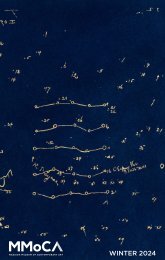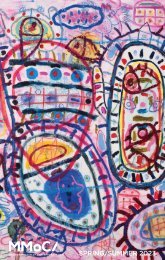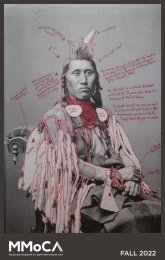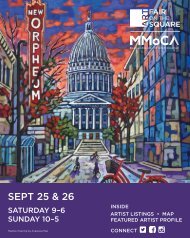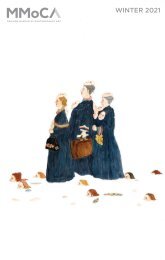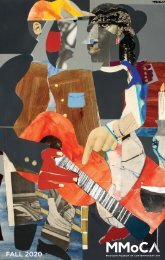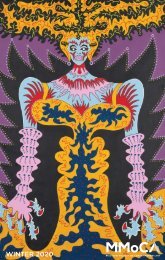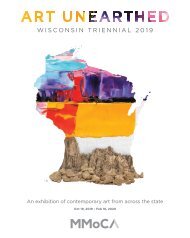Kambui Olujimi: Zulu Time exhibition catalog
This catalog is from the installation of this exhibition at MMoCA. It includes essays by Sampada Aranke, Leah Kolb, and Gregory Volk.
This catalog is from the installation of this exhibition at MMoCA. It includes essays by Sampada Aranke, Leah Kolb, and Gregory Volk.
You also want an ePaper? Increase the reach of your titles
YUMPU automatically turns print PDFs into web optimized ePapers that Google loves.
Below:<br />
Frederic Edwin Church<br />
(American, 1826–1900)<br />
Twilight in the Wilderness,<br />
1860<br />
Oil on canvas<br />
framed: 124 x 185 x 13 cm<br />
(48 13/16 x 72 13/16 x 5<br />
1/16 in)<br />
unframed: 101.6 x 162.6 cm<br />
(40 x 64 in)<br />
The Cleveland Museum of<br />
Art, Mr. and Mrs. William<br />
H. Marlatt Fund 1965.233<br />
Facing:<br />
Untitled (detail),<br />
from T-Minus Ø<br />
digitally altered the images to create layered, composite works that are<br />
both found and meticulously constructed, and then digitally printed them<br />
on both sides of the flags. The images are harrowing, but they are also<br />
gorgeous, even sublime. Printed directly on cotton fabric, this imagery<br />
constitutes a highly unorthodox kind of digital-era painting sans paint.<br />
Furthermore, these twenty-first-century “paintings” of high-tech mayhem<br />
connect visually with Romantic nineteenth-century landscape paintings.<br />
One of <strong>Olujimi</strong>’s untitled flags from this series shows curving white smoke,<br />
billowing pink smoke, and delicate smoke tendrils tinged with turquoise.<br />
Like other works in the series, it evokes a nineteenth-century aptitude for<br />
vastness and wonderment in nature—think of the stunning white, blue,<br />
and orange skies of Caspar David Friedrich (1774–1840); the overwhelming,<br />
multicolored sky in Frederic Church’s masterpiece Twilight in the Wilderness<br />
(1860), and the many awe-inspiring paintings of the American West by<br />
Albert Bierstadt (1830–1902) and Thomas Moran (1837–1926). Streaking<br />
across a deep blue sky, the smoke and debris, colored white, turquoise,<br />
dark red, orange, purple, and yellow, in the image on the back side of<br />
this same work, would look fine paired with any number of landscape<br />
paintings featuring similar colors and surging energies by J.M.W. Turner.<br />
Unlike traditional paintings, <strong>Olujimi</strong>’s canvases extend from the<br />
wall on aluminum poles, thus providing more complexity and another layer<br />
of meaning. This row of flags resembles what one might see in a conference<br />
room at the United Nations, but instead of signifying countries, the flags<br />
display disaster after disaster. In a time when so much of the world is<br />
convulsed by strife, and when the utopian promise of a gorgeous, high-tech<br />
future seems deeply suspect, this work by <strong>Olujimi</strong> is exceptionally apt.<br />
View <strong>Kambui</strong> <strong>Olujimi</strong>’s wall-sized composite photograph Ville<br />
Radieuse, habite-à-machine (The Radiant City, the living machine), 2017,<br />
with Bakhtin’s notion of carnivalization in mind. The work is rooted in two<br />
familiar items: wheat-paste posters common on city streets and decorative<br />
wallpaper in a home. Twenty-five paper sheets form a rhythmic, almost<br />
percussive, image of the massive St. Louis housing project Pruitt-Igoe<br />
being detonated in 1972. Rarely has such a grand and monumental urban<br />
renewal project gone so wrong so quickly, and its demise is documented<br />
here with sagging buildings and erupting smoke. Pruitt-Igoe was the first<br />
major project for architect Minoru Yamasaki (1912–1986), an American of<br />
Japanese descent who later designed the World Trade Center. Pruitt-Igoe<br />
opened in 1954 and rapidly declined for socio-political reasons involving<br />
poverty, government neglect, incompetence, racial bias, and a chronic<br />
lack of funding for basic maintenance. Based on an iconic photograph of<br />
the project’s demolition, <strong>Olujimi</strong>’s composite image revisits a signature<br />
historical event but also suggests that the issues surrounding Pruitt-Igoe<br />
remain pertinent. It also connects a planned, manmade disaster with<br />
world-shaping natural forces like earthquakes. On a neighboring wall,<br />
48 49






